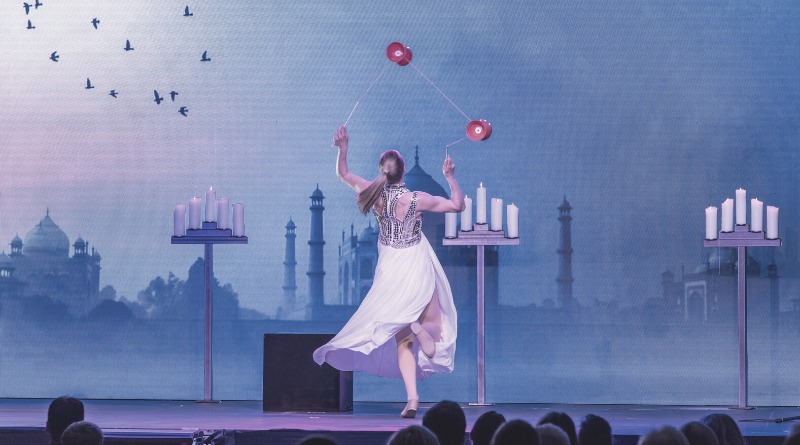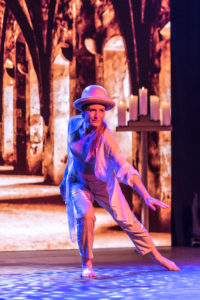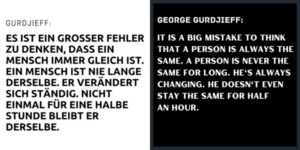Overcoming Stage Fright

Even veteran performers can find themselves feeling paralyzed when it comes time to face the audience. German juggler and meditation coach Lena Köhn offers fellow artists a four-pronged approach to take the reins back from their stage fright and tackle fear from every angle.
Stage fright can be so frustrating. Some artists spend years and years of practice perfecting their skills. They put all their heartfelt passion into their creations—but when it is finally time to shine and share their talent with the audience, some strange force takes over and makes them lose all of that competence. And what ought to be a joyful experience—something that they worked really hard to achieve— turns into a moment of fear and failure. These situations can seriously impact an artist’s confidence and joy and hinder the expression of their innermost essence and sharing their special gift with the world.
Have you ever encountered that paralyzing fear of public speaking or performing? That sense that there is a sudden shift happening within you at the moment when all the attention is on you—and suddenly, you start feeling shaky and stiff when you know that NOW is when it counts? Are you curious to understand this phenomenon?

I have experienced this myself. Juggling is a very delicate technique, which requires maintaining a strong focus and the ability to disregard all distracting thoughts. Being able to deliver a consistent quality of performance in front of 2,000 spectators regardless of outer and inner circumstances has been essential in my career of 20+ years as an international artist. In the process of reaching this level, I have learned to address the issue of stage fright from different angles and in great depth.
The search for a solution motivated me to contemplate and dive deep into the nature of the mind, which proved to be an extremely exciting journey that was so rewarding to me. So, aside from my work as a performer, I completed a meditation teacher’s training and coaching education. During this process, I discovered that there is not one solution, but four different facets that complement each other. I will give you a detailed description of these angles and how to deal with them.
But first, let’s uncover why stage fright is so sticky, so difficult to brush aside.
The stage works like a magnifying glass for all of our insecurities and fears. These surface especially when we face an anonymous group of people (which is a perfect breeding ground for countless projections) and we wish to showcase only the best version of ourselves. The upside to this intense challenge is that working through stage fright will teach you a great deal about yourself and, consequently, also improve your life off-stage. This process gives you the freedom to kiss perfectionism goodbye and plunge into a new, exciting aliveness that holds space for great achievements.
My approach to dissolving stage fright is very holistic, something which I feel is lacking in most other methods. We need to look at all the different facets of stage fright, because we are multifaceted beings. Our body, our emotions, our identity, and our belief system are interlinked and influence each other. Let me give a quick overview of the elements that I’ve identified as crucial to be addressed during this process:
1. The body:

Many people encounter physical symptoms before or during performing, such as sweaty hands, shallow breath, soft knees, stiffness, restlessness…
These are stress reactions produced by our autonomic nerve system. Noticing that we are seemingly not in full control of our body and that something seems to be “off,” can easily start a vicious cycle of more fear and insecurity.
But there are well-known techniques to control this physical aspect, such as breathing exercises, meditation, and visualizations, and these methods have been proven to provide quick results. As the world-famous psychologist Fritz Perls puts it, “Fear is excitement without the breath,” which indicates that we can transform fear back into positive excitement. (Being able to do this efficiently was a major leap on my own path!!!)
2. Emotions and beliefs:
On the level of emotions, it is necessary to look into the root causes of our fear and pain. Often the situation of being on stage triggers memories of unresolved past events that led us to self-doubt; irrational, intrapersonal conflicts; and a distorted self-image. As a result of all these imprints, we feel overly vulnerable and exposed if mistakes happen.
In my coaching training, I learned effective tools to resolve these imprints and form a new and healthier outlook on ourselves, our lives and our abilities. Among them are two very helpful processes. The first exercise, “from emotion to will,” is where we uncover the hidden wish that we try to fulfill by giving a successful performance, and then learn how to redirect it in a way that is more realistic and attainable—so that achieving it does not depend on any events in the outer world, but nourishes us from the inside. This releases the inner pressure that we put on ourselves and liberates our art to stand for itself, rather than serve as a means to cover for an unfulfilled need.
Second, the expansion method is an extremely powerful tool to work with resolving unhealthy beliefs resulting from overpowering events and our assimilation of negative feedback. Even seemingly small events like a critical comment from our caretakers can leave a negative imprint, let alone the big challenges in life: the moments in which we felt helpless and victimized. By expanding our consciousness through a very accessible technique, we can then reevaluate the distorted conclusions that we made about ourselves and about life and form a more realistic, positive outlook that embraces moments of weakening without letting them shake us to the core of our being.
3. Presence and focus:
As a third tool, it is beneficial to work on an increased presence. In my training with jugglers, I offer them my own definition: “Stage fright is the result of the attempt to catch a ball before you have even thrown it.”
Take a moment to read that again. Sounds crazy, doesn’t it? But that is exactly what happens. When we are afraid of failing on stage, our brain creates a distorted perception of time. It tries to control what is actually located in the future and is thus out of our control at this very moment. As a result of undertaking this unsolvable challenge, the brain gets stressed and sends stress signals to the body, which tampers with our ability to focus and function well.

The key is, to learn how to be in time, how to be in the present moment; how to direct our attention and do one thing after the next with the right amount of focus and flow. In my meditation teacher’s training, I studied powerful knowledge and exercises to achieve that state of maximum presence.
Attention, focus, and awareness can all be practiced, and it is so helpful to be able to understand and navigate these three aspects. To focus means that you narrow your attention to a specific object or movement—for example, by focusing on your breath without manipulating it, and observing when your attention drifts away and slowly bringing it back. That is a practice of focus: you are directing your attention.
Awareness can be practiced by just fully being present without choosing an object of attention. Just notice what is catching your attention; is it the sound of cars passing by? The art of this is to stay fully with what is—to notice also the thoughts that show up in your mind without evaluating or reacting to them. Once you start to look at your thoughts with curiosity, you will notice more and more the gaps between the thoughts. Open awareness without a focus is a state of meditation.
For the stage, you need both focus and awareness. Attention works like the lens of a microscope: you need to be able to direct your attention and find the optimum balance to achieve sharpness and ease that help you execute your act.
4. Our identity:
There is one key that can resolve all issues at once: it is our sense of identity. Most Western psychology practice focuses on cultivating a positive self-image by working to resolve negative beliefs, using affirmations, and stretching our ability to face unpleasant situations. This certainly is helpful, and it is also necessary to undo the negative imprints on our beings, but these methods can only get you to a certain level and they require constant work, as reality might challenge this constructed positivity.

The more radical approach, which is common in Eastern philosophy, is to reveal that our identity is a constructed illusion that limits us. This can be clearly observed when we work on stage, because we want to create a positive version of ourselves that pleases us, our audience, our colleagues and our clients. But on a closer look, it is easy to realize that this identity does not really have any substance. As humans, we undergo continuous change; there is nothing fixed and static about us. On one day we might shine, while on another, we might fall short of a certain challenge. Mistakes happen. It is the same for everyone and therefore is not a personal flaw or failure, and it certainly does not tell us anything about “who we are.”
Once this realization of emptiness and impermanence registers profoundly within our being, we can easily move beyond any identity and dive into freedom and flow.
5. One more important aspect:
Okay, I spoke of four tools initially, but here is a little bonus.
It is humor! Before going on stage, I often use a little personal mantra, and it is really fun to share that with my clients. It immediately makes me smile about myself and how I created an inflated sense of self-importance. After all, we are in the entertainment business; we are not saving people’s lives. The audience is there to have fun, and in order for them to have fun, I need to let go, relax, and have fun myself.

I hope that reading this information has already made an impact on the way you perceive stage fright. I am very grateful to be able to share my knowledge and insights with you. If you are interested in experiencing some more of these teachings and exercises, feel free to reach out regardless of where in the world you might be. I work mostly via Zoom due to my travel schedule as an artist. It is a great joy for me to go through the four-stage process with my clients and watch them grow. Their amazing feedback makes it really rewarding to take the time and do this work alongside my own artistic career.
Already, now, you might be able to identify which of the four dimensions we have discussed might be most relevant for you. Realizing what is really happening in our inner world is the first step towards change, so I would recommend that if you experience stage fright again, just take a moment to step back and check in with yourself on what is going on. Remind yourself that fear is just a feeling, nothing more, and that your body knows how to do its job, and that you can rely on that.
Go rock that stage and enjoy your moment!
Images of Lena credited to photographer Alexander Brandl
Editor's Note: At StageLync, an international platform for the performing arts, we celebrate the diversity of our writers' backgrounds. We recognize and support their choice to use either American or British English in their articles, respecting their individual preferences and origins. This policy allows us to embrace a wide range of linguistic expressions, enriching our content and reflecting the global nature of our community.
🎧 Join us on the StageLync Podcast for inspiring stories from the world of performing arts! Tune in to hear from the creative minds who bring magic to life, both onstage and behind the scenes. 🎙️ 👉 Listen now!
